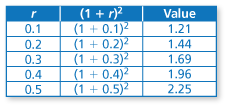-
Here is another way to solve Example 6. (You may want to review the Math Help for page 152 and read the discussion about growth factor before continuing.)
First, consider the exponential growth of an amount that doubles every year. The growth factor for this amount is equal to 2 and can be written as

In Example 6, you want to determine the annual rate of growth represented by Moore's Law. Moore's Law states that the number of transistors that can be placed inexpensively on an integrated circuit will double every two years. Because the amount doubles every two years, the square of the growth factor is equal to 2 and is written as

To find the annual rate of growth, substitute a few values for r and evaluate.

So, the value of r must be between 0.4 and 0.5. Next, try values of r starting with r = 0.40.

You now have a better estimate of r, which is 0.41 or 41%. You can continue this process of guessing, checking, and revising to obtain
 , which corresponds to a growth factor of
, which corresponds to a growth factor of
every two years. So, the annual rate of growth is about 41.42%.
-
In 2000, Jack Kirby won the Nobel Prize in Physics for inventing the integrated circuit in 1958. Integrated circuits are found in almost all electronic devices because they can be produced at such a low cost. Gordon Moore, one of the founders of Intel once said, "If the auto industry advanced as rapidly as the semiconductor industry, a Rolls Royce would get a half a million miles per gallon, and it would be cheaper to throw it away than to park it." Visit the Nobel Prize website to read this quote, more about the history of the integrated circuit, and how they are created today.
-
You are given the initial value,
 , and the rate of growth,
, and the rate of growth,  The elapsed time is the difference in the years,
The elapsed time is the difference in the years,  The formula for this exponential growth is
The formula for this exponential growth is
So, about 1,899,960,845 transistors could be placed on an integrated circuit in 2010.
-
Comments (1)
These comments are not screened before publication. Constructive debate about the information on this page is welcome, but personal attacks are not. Please do not post comments that are commercial in nature or that violate copyright. Comments that we regard as obscene, defamatory, or intended to incite violence will be removed. If you find a comment offensive, you may flag it.
When posting a comment, you agree to our Terms of Use.Showing 1 commentsSubscribe by email Subscribe by RSSRon Larson (author)1 decade ago |When I was writing this example, I was fascinated at how the famous irrational number "square root of 2" turns out to be the annual rate of increase in Moore's Law.0 1





